Discover 35 hidden attractions, cool sights, and unusual things to do in Knoxville (United States). Don't miss out on these must-see attractions: World's Fair Park, Knoxville Civic Coliseum, and Volunteer Landing. Also, be sure to include Blount Mansion in your itinerary.
Below, you can find the list of the most amazing places you should visit in Knoxville (Tennessee).
Table of Contents
World's Fair Park

Park in Knoxville, Tennessee. World's Fair Park is a public park in downtown Knoxville, Tennessee. The park sits on the former fairgrounds of the 1982 World's Fair hosted in Knoxville. Today, the park is home to the Sunsphere and the Tennessee Amphitheater, the two remaining structures from the exposition.[1]
Knoxville Civic Coliseum

Arena in Knoxville, Tennessee. General James White Memorial Civic Auditorium and Coliseum is a multi-purpose events facility in Knoxville, Tennessee, owned by the Knoxville city government and managed by SMG. Its components are an auditorium with a maximum seating capacity of 2,500, a multi-purpose arena with a maximum seating capacity of 6,500, an exhibition hall and a reception hall. It was built in 1961.
The arena is home to the Knoxville Ice Bears, of the SPHL and the University of Tennessee Ice Vols, of the ACHA. In the past, the arena hosted the Knoxville Speed, of the UHL, the Knoxville Cherokees, of the ECHL and the Knoxville Knights, of the EHL. It was also the home of the Tennessee ThunderCats/Riverhawks professional indoor football franchise.
It was the main home arena for Smoky Mountain Wrestling, a regional wrestling promotion, run by pro wrestling Hall of Famer Jim Cornette from 1992 to 1995.
Performances hosted in the facility have included circuses, plays and musicals, symphony orchestra concerts, popular music concerts, and comedians. On March 18, 1982, the venue was notable to be the site of Randy Rhoads' final show, before his death in a plane crash the very next day.
Chicago broke the record (at that time) for the fastest sellout to a concert at the Coliseum for their August 26, 1971, performance.[2]
Address: 500 Howard Baker Jr Blvd, 37915 Knoxville (East Knoxville)
Volunteer Landing
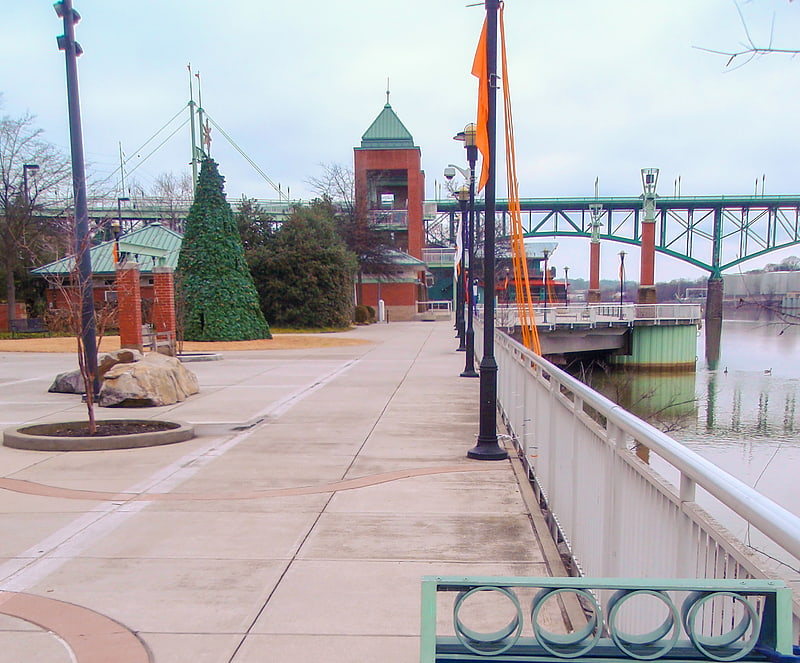
Volunteer Landing is a public park and riverwalk along the Tennessee River in Knoxville, Tennessee. It is below the Gay Street Bridge.[3]
Address: 500 Neyland Dr, 37902-2716 Knoxville
Blount Mansion
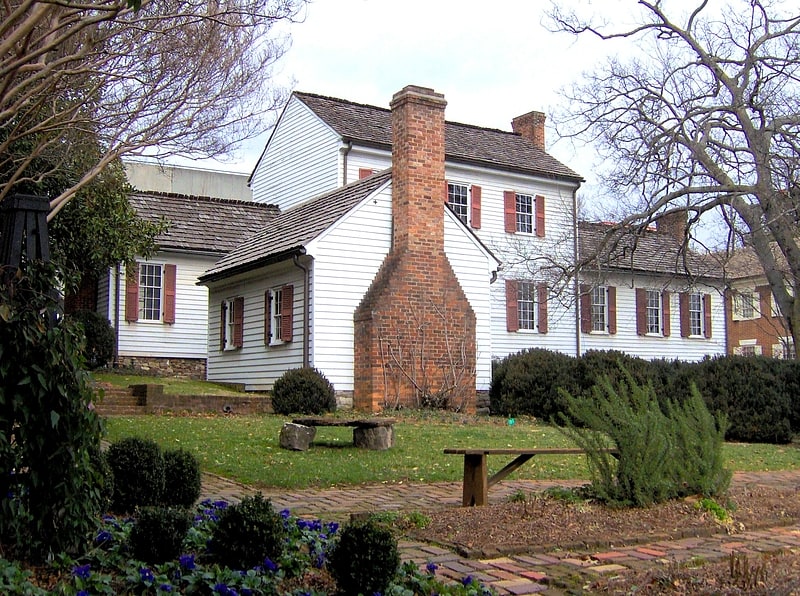
Historical place museum in Knoxville, Tennessee. The Blount Mansion, also known as William Blount Mansion, located at 200 West Hill Avenue in downtown Knoxville, Tennessee, was the home of the only territorial governor of the Southwest Territory, William Blount. Blount, also a signer of the United States Constitution and a U.S. Senator from Tennessee, lived on the property with his family and ten African-American slaves. The mansion served as the de facto capitol of the Southwest Territory. In 1796, much of the Tennessee Constitution was drafted in Governor Blount's office at the mansion. Tennessee state historian John Trotwood Moore once called Blount Mansion "the most important historical spot in Tennessee."
The house is a wood-frame home sheathed in wood siding, built with materials brought from North Carolina in an era when most homes in Tennessee were log cabins. The two-story central portion of the home is the oldest section. The one-story west wing is believed to have been constructed next; archaeologists suspect the west wing was originally an outbuilding, which was then moved and attached to the main house, and there is some evidence the west wing was originally the servants' quarters. The one-story east wing was the final section to be constructed, perhaps as late as 1820. Blount's office, from which he governed and conducted his business affairs, was built along with the house and is a one-story, free-standing building and had a modest front porch.
By 1925, the house had deteriorated, and a local developer, B.H. Sprankle, intended to demolish it and replace it with a parking lot to serve the new Andrew Johnson Hotel, then under construction. The Blount Mansion Association was chartered the following year, and after a massive publicity campaign by Mary Boyce Temple and the Bonnie Kate Chapter of the Daughters of the American Revolution and the East Tennessee Historical Society, the Association raised enough money to purchase the house in 1930. The Blount Mansion Association has since maintained the house as a museum, and has made numerous renovations to restore the house and property to its late 18th-century appearance. In the 1960s, the mansion was designated a National Historic Landmark.[4]
Address: 200 W Hill Ave, 37902-1812 Knoxville
Knoxville Museum of Art

Museum in Knoxville, Tennessee. The Knoxville Museum of Art, is an art museum in Knoxville, Tennessee. It specializes in historical and contemporary art pieces from the East Tennessee region. According to its mission statement, the museum "celebrates the art and artists of East Tennessee, presents new art and new ideas, educates and serves a diverse community, enhances Knoxville’s quality of life, and operates ethically, responsibly, and transparently as a public trust."[5]
Address: 1050 Worlds Fair Park Dr, 37916-1653 Knoxville
Neyland Stadium
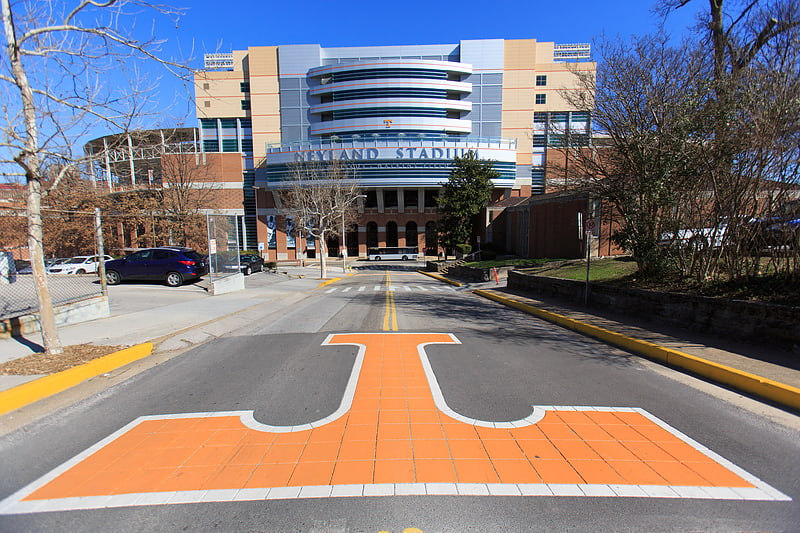
Stadium in Knoxville, Tennessee. Neyland Stadium, is a sports stadium in Knoxville, Tennessee, United States. It serves primarily as the home of the Tennessee Volunteers football team, but is also used to host large conventions and has been a site for several National Football League exhibition games. The stadium's official capacity is 102,455. Constructed in 1921 as Shields–Watkins Field, the stadium has undergone 16 expansion projects, at one point reaching a capacity of 104,079 before being slightly reduced by alterations in the following decade. Neyland Stadium is the fifth largest stadium in the United States, the seventh largest stadium in the world, and the second largest stadium in the Southeastern Conference. The stadium is named for Robert Neyland, who served three stints as head football coach at the University of Tennessee between 1926 and 1952.[6]
Address: 1235 Phillip Fulmer Ave, 37996-4511 Knoxville
Zoo Knoxville

Animal park emphasizing education. Zoo Knoxville, formerly known as the Knoxville Zoo or Knoxville Zoological Gardens, is a 53-acre zoo located just east of downtown Knoxville, Tennessee, United States, near exit 392 off Interstate 40. The zoo is home to about 800 animals and welcomes over 400,000 visitors each year.
Zoo Knoxville is notable for having bred the first two African Elephants born in the Western Hemisphere in 1978. The zoo also has bred more endangered red pandas than any other zoo in the world and is a leader in the breeding of endangered tortoises.
The zoo is accredited by the Association of Zoos and Aquariums (AZA).[7]
Address: 3500 Knoxville Zoo Dr, 37914-4416 Knoxville (East Knoxville)
Thompson–Boling Arena

Arena in Knoxville, Tennessee. Thompson–Boling Arena is a multi-purpose arena on the campus of the University of Tennessee in Knoxville, Tennessee. The arena opened in 1987. It is home to the Tennessee Volunteers and Lady Vols basketball teams. Since 2008, it has been home to the Lady Vols volleyball team. It is named after B. Ray Thompson and former university president Edward J. Boling. The basketball court is named "The Summitt" after the late Lady Vols basketball coach Pat Summitt. It replaced the Stokely Athletic Center. The mammoth octagonal building lies just northwest of the Tennessee River, and just southwest of Neyland Stadium. As an echo of its neighbor and a tribute to the brick-and-mortar pattern atop Ayres Hall, the baselines of the court are painted in the familiar orange-and-white checkerboard pattern.[8]
Address: 1600 Phillip Fulmer Ave # 202, 37996-4511 Knoxville
Bijou Theatre
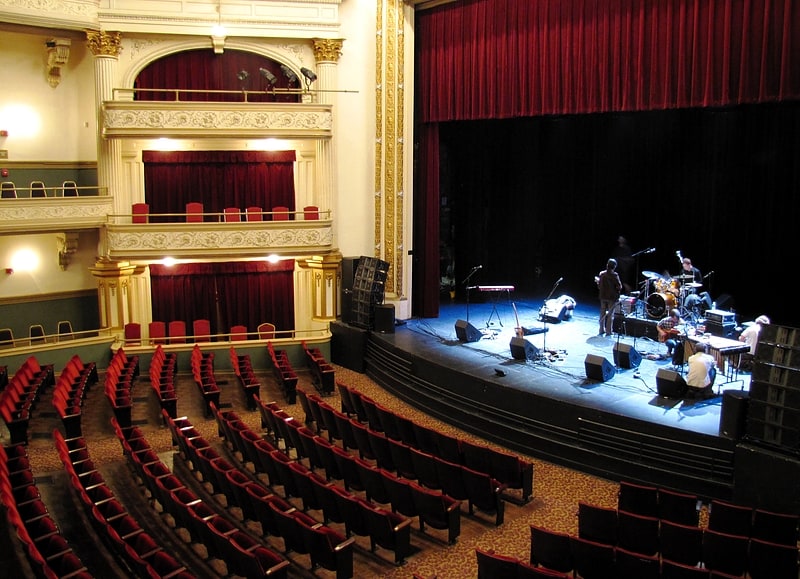
Theater in Knoxville, Tennessee. The Bijou Theatre is a theater located in Knoxville, Tennessee, United States. Built in 1909 as an addition to the Lamar House Hotel, the theater has at various times served as performance venue for traditional theatre, vaudeville, a second-run moviehouse, a commencement stage for the city's African-American high school, and a pornographic movie theater. The Lamar House Hotel, in which the theater was constructed, was originally built in 1817, and modified in the 1850s. The building and theater were added to the National Register of Historic Places in 1975.
The Lamar House Hotel was built by Irish immigrant Thomas Humes and his descendants, and quickly developed into a gathering place for Knoxville's wealthy. In 1819, Andrew Jackson became the first of five presidents to lodge at the hotel, and in the early 1850s, local businessmen purchased and expanded the building into a lavish 75-room complex. During the Civil War, the Union Army used the hotel as a hospital for its war wounded, among them General William P. Sanders, who died at the hotel in 1863. Following the war, the hotel became the center of Knoxville's Gilded Age extravagance, hosting lavish masquerade balls for the city's elite.
In 1909, the rear wing of the building was replaced by the Bijou Theatre structure, entered through a new lobby cut through the hotel building from Gay Street. The theater opened on March 8, 1909, and over the next four decades would host performers such as the Marx Brothers, Dizzy Gillespie, John Philip Sousa, the Ballets Russes, Ethel Barrymore, Alfred Lunt and Lynn Fontanne, John Cullum, and Houdini. After a period of decline in the 1960s and early 1970s, local preservationists purchased the building and renovated the theater.[9]
Address: Knoxville, 803 S Gay St, Knoxville, TN 37902-1711
House Mountain
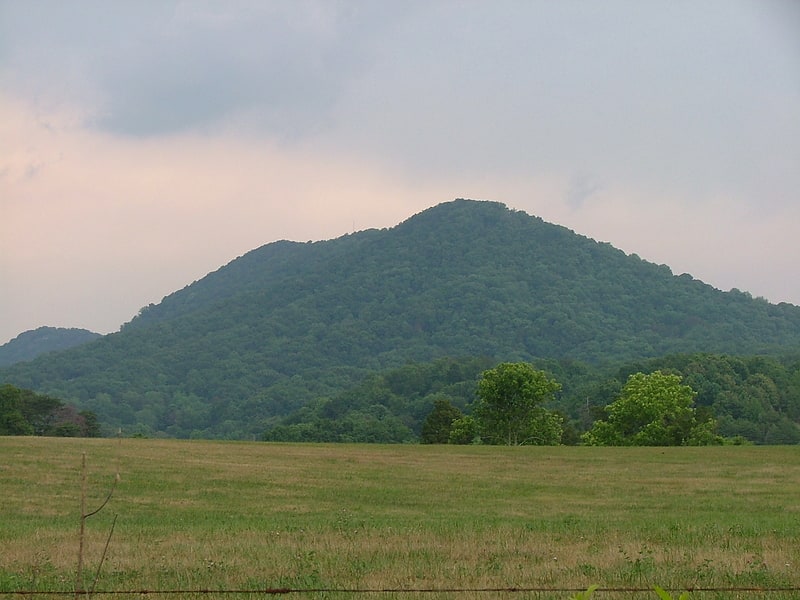
Mountain in Tennessee. House Mountain is a mountain located in Corryton, Tennessee, United States, about 8 miles northeast of Knoxville. Rising to an elevation of 2,064 feet above sea level, House Mountain is the highest point in Knox County.
The House Mountain State Natural Area— designated in 1987— consists of 527 acres (2.13 km2), mostly on the south side of the mountain. House Mountain is known for its huge sandstone boulders, its wide variety of bird and plant life, and for the views from its two peaks. On a clear day, the Great Smoky Mountains and the upper Unaka Range are visible to the south and east, the Cumberland Plateau is visible to the west, and Powell Mountain and Clinch Mountain are visible to the north and northeast.
The origin of the mountain's name is unknown, though a local legend suggests early settlers thought the mountain was shaped like the roof of a house.[10]
Old City Hall

Historical place in Knoxville, Tennessee. Old City Hall is a complex of historic buildings located at 601 West Summit Hill Drive in Knoxville, Tennessee, United States. Originally constructed in 1848 as the Tennessee School for the Deaf and Dumb, the complex served as Knoxville's city hall from 1925 until 1980. The complex has been listed on the National Register of Historic Places and has been documented by the Historic American Buildings Survey. It currently houses Lincoln Memorial University's Duncan School of Law.[11]
Women's Basketball Hall of Fame
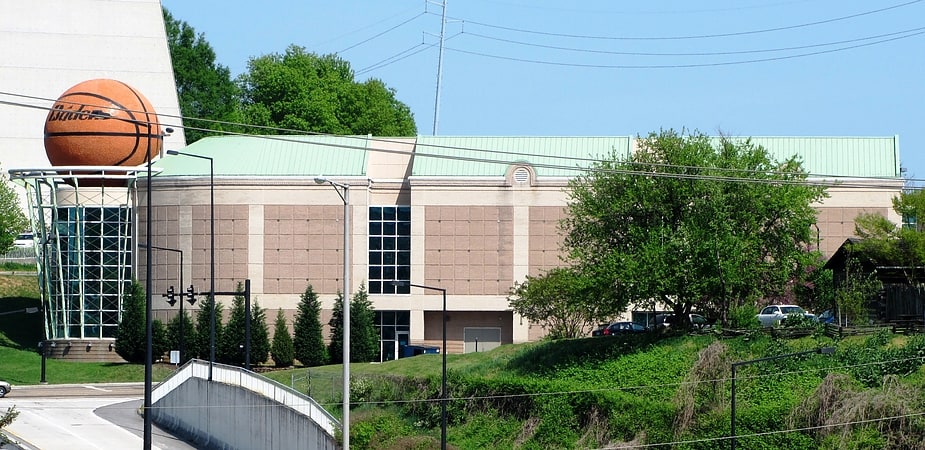
Museum devoted to female basketballers. The Women's Basketball Hall of Fame honors those who have contributed to the sport of women's basketball. The Hall of Fame opened in 1999 in Knoxville, Tennessee, USA. It is the only facility of its kind dedicated to all levels of women's basketball. Knoxville is known for having a large women's basketball following as well as being the home of the University of Tennessee's Lady Vols basketball team previously coached by women's coach Pat Summitt, who was part of the first class inducted. With the 2017 Induction, the Women's Basketball Hall of Fame celebrated its 19th anniversary and added six new members to its hall, honoring 157 inductees.
Inductees may be nominated in the following categories: Coach, Veteran Coach, Player, International Player, Veteran Player, Contributor, and Official.[12]
Address: 700 S Hall of Fame Dr, 37915 Knoxville (East Knoxville)
The Henley Bridge

Arch bridge in Knoxville, Tennessee. The Henley Bridge, sometimes referred to as Henley Street Bridge, is a vehicle bridge that crosses the Tennessee River in Knoxville, Tennessee, United States. Completed in 1931, the 1,793-foot bridge is one of four vehicle bridges connecting Downtown Knoxville with South Knoxville, the other three being the Gay Street Bridge, the Buck Karnes Bridge, named for James Ernest Karnes, and the James C. Ford Memorial Bridge. The bridge carries U.S. Route 441, which is known as "Henley Street" in downtown Knoxville and "Chapman Highway" in South Knoxville.
The bridge and its associated street are named for Colonel David Henley, a Revolutionary War officer and War Department agent stationed in Knoxville in the 1790s.[13]
Lebanon in the Forks Cemetery
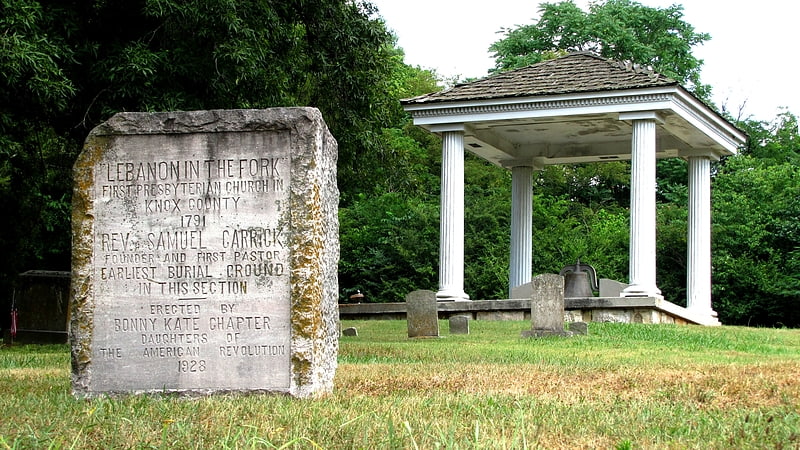
The Lebanon in the Fork Cemetery, also known as Three Rivers Cemetery, is a historic cemetery located at 2390 Asbury Road in eastern Knoxville, Tennessee, U.S..[14]
Sunsphere
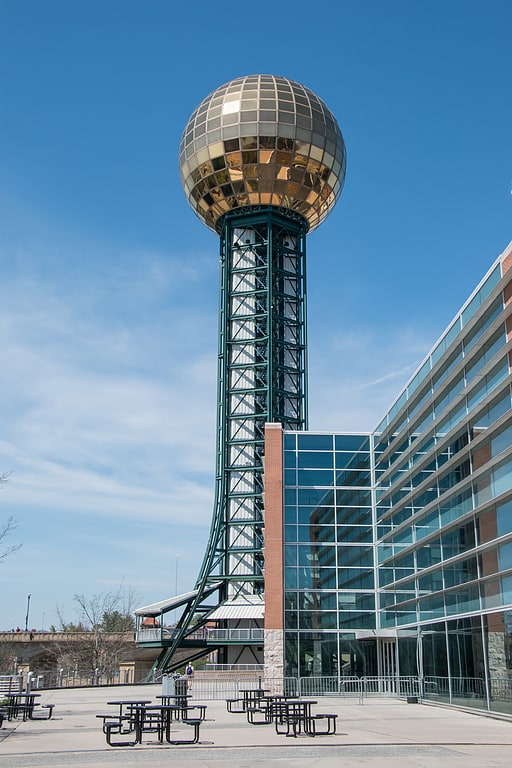
Historical landmark in Knoxville, Tennessee. The Sunsphere, located in World’s Fair Park in downtown Knoxville, Tennessee, is a 266-foot high hexagonal steel truss structure, topped with a 75 ft gold-colored glass sphere that served as the symbol of the 1982 World's Fair.[15]
Church Street United Methodist Church
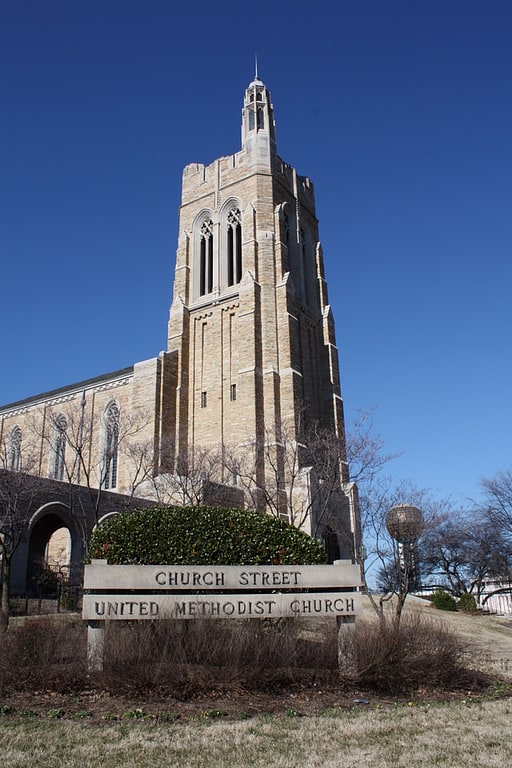
United methodist church in Knoxville, Tennessee. Church Street United Methodist Church is a United Methodist church located on Henley Street in downtown Knoxville, Tennessee. The church building is considered a Knoxville landmark and is listed on the National Register of Historic Places.[16]
Address: 900 Henley St, 37902 Knoxville
Gay Street Bridge
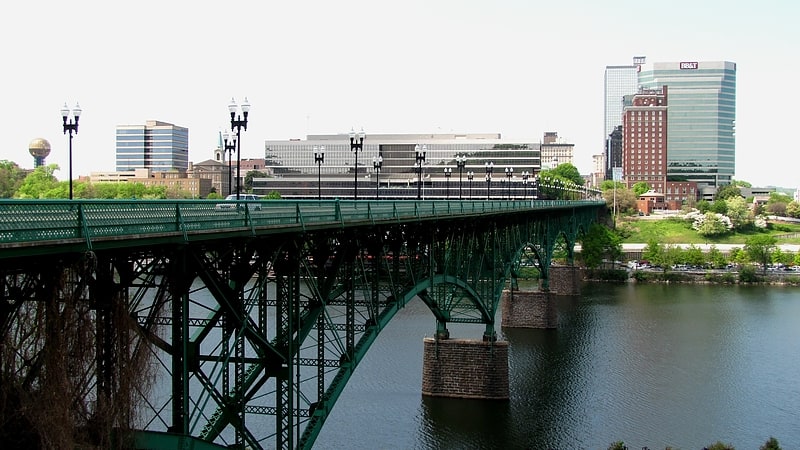
Arch bridge in Knoxville, Tennessee. The Gay Street Bridge is a vehicle bridge that crosses the Tennessee River in Knoxville, Tennessee, United States. Completed in 1898, the 1,512-foot bridge is the oldest of four vehicle bridges connecting Downtown Knoxville with South Knoxville, the other three being the Henley Street Bridge, the James E. "Buck" Karnes Bridge, and the James C. Ford Memorial Bridge.[17]
Ramsey House
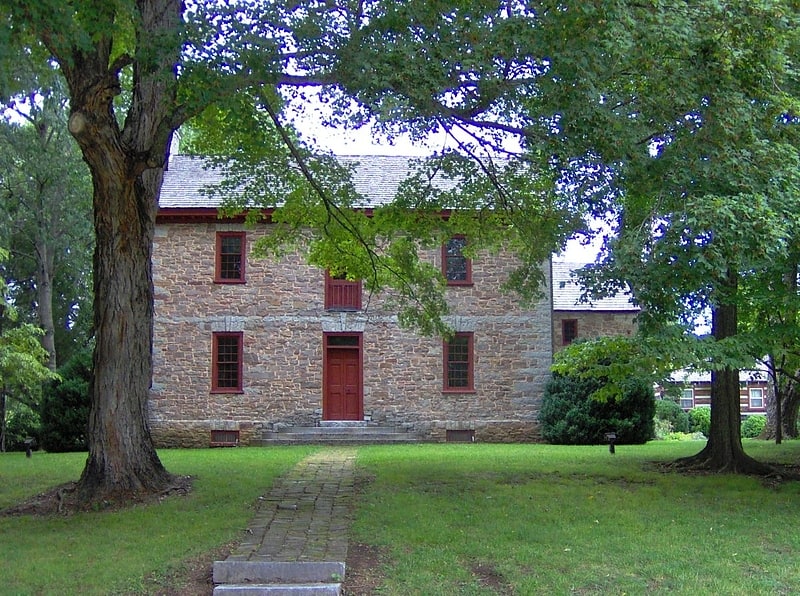
Historical place museum in Knox County, Tennessee. The Ramsey House is a two-story stone house in Knox County, Tennessee, United States. Also known as Swan Pond, the house was constructed in 1797 by English architect Thomas Hope for Colonel Francis Alexander Ramsey, whose family operated a plantation at the site until the U.S. Civil War. In 1969, the house was added to the National Register of Historic Places for its architecture and its role in the region's early 19th-century history.
Francis Alexander Ramsey arrived in what is now Greene County in 1783, and shortly thereafter made a surveying trip down the Holston River, where he first identified the future site of the Ramsey House. Throughout the 1780s, he served as an official of the fledgling State of Franklin, and later served in various capacities in the governments of the Southwest Territory and the State of Tennessee. Ramsey's children included early Knoxville mayor, W. B. A. Ramsey, and early Tennessee historian and businessman, J. G. M. Ramsey, both of whom occupied the Ramsey House at various times. Due to their Confederate sympathies, the Ramseys fled Knoxville when the Union Army occupied the city during the Civil War, and the family sold the house in 1866.
The Knoxville Chapter of the Association for the Preservation of Tennessee Antiquities (APTA) purchased the Ramsey House in 1952, and currently maintains the house and grounds as a museum.[18]
Address: 2614 Thorngrove Pike, 37914-9704 Knoxville
Marble Springs
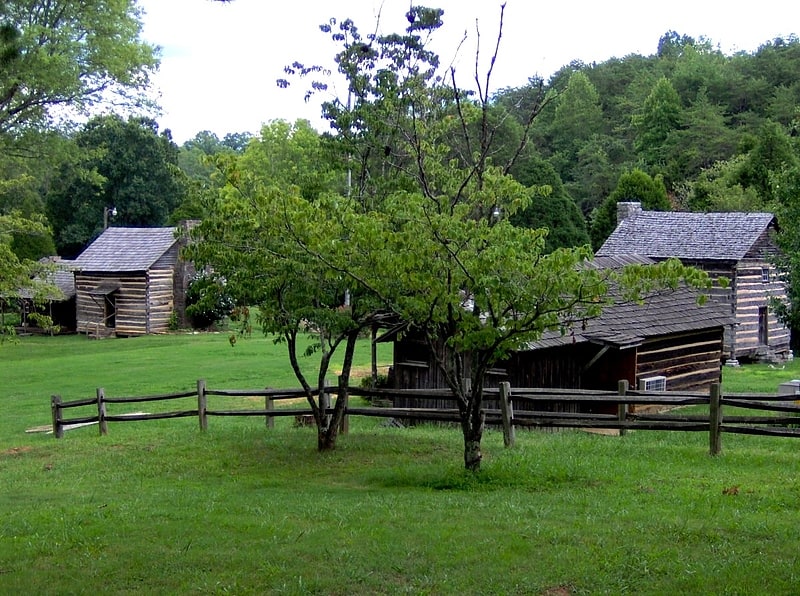
Building in Knox County, Tennessee. Marble Springs, also known as the Gov. John Sevier Home, is a state historic site in south Knox County, Tennessee, in the southeastern United States. The site was the home of John Sevier —a Revolutionary War and frontier militia commander and later the first governor of Tennessee—from 1790 until his death in 1815. A cabin at the site was once believed to have been Sevier's cabin, although recent dendrochronological analyses place the cabin's construction date in the 1830s, well after Sevier had died.
Along with the "Sevier" cabin, several out-buildings have been moved from elsewhere in East Tennessee and several have been reconstructed to simulate a typical pioneer farm from Sevier's time. The 35.4-acre (0.143 km2) site also includes a pavilion and an outdoor stage. The site is managed for the Tennessee Historical Commission by the Governor John Sevier Memorial Association.[19]
Address: 1220 W Governor John Sevier Hwy, 37920-6210 Knoxville
Tennessee Woman Suffrage Memorial
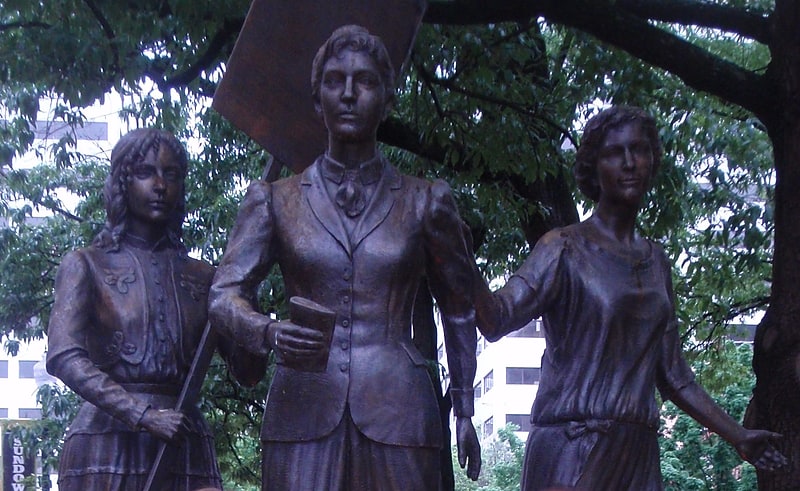
Sculpture by Alan LeQuire. The Tennessee Woman Suffrage Memorial is located at Market Square in downtown Knoxville, Tennessee, United States. It honors the women who campaigned for the state to ratify the Nineteenth Amendment to the United States Constitution to give women the right to vote. Tennessee was the final state to ratify the amendment and have it added to the Constitution, and thus was the focus of considerable effort both from local women and women who travelled from other states to assist them. The ratification vote was passed on August 18, 1920.
The sculpture was commissioned by the Suffrage Coalition and designed and created by Alan LeQuire. It was unveiled on August 26, 2006, as part of a day of commemorations, which included a re-enactment of a suffrage march, with women in vintage clothes and replica sashes, and carrying replica banners. Martha Craig Daughtrey was the speaker at the unveiling; she was the first female judge on a Tennessee court of appeals and the first woman on the Tennessee Supreme Court.
The bronze sculpture depicts three women who were leading campaigners for women's suffrage: Elizabeth Avery Meriwether of Memphis, Lizzie Crozier French of Knoxville, and Anne Dallas Dudley of Nashville. The base of the sculpture features text on the campaign and a number of quotations from the campaigners, including the following by Harriot Eaton Stanton Blatch:
"All honor to women, the first disenfranchised class in history who unaided by any political party, won enfranchisement by its own effort alone, and achieved the victory without the shedding of a drop of human blood."[20]
Mabry-Hazen House

Museum in Knoxville, Tennessee. The Mabry–Hazen House is a historic home located on an 8-acre site at 1711 Dandridge Avenue in Knoxville, Tennessee, at the crest of Mabry's Hill. Also known as the Evelyn Hazen House or the Joseph Alexander Mabry Jr. House, when constructed in 1858 for Joseph Alexander Mabry II it was named Pine Hill Cottage. The house was in what was then the separate town of East Knoxville. Stylistically, the house exhibits both Italianate and Greek Revival elements. Additions in 1886 increased the size of the first floor. Having operated as a museum since the death of Evelyn Hazen, the house retains its original furniture and family collections, including antique china and crystal with over 2,000 original artifacts on display making it the largest original family collection within America. The house is listed on the National Register of Historic Places.
At the outset of the American Civil War, Joseph Mabry II, a wealthy Knoxville merchant and importer, pledged $100,000.00 to outfit an entire regiment of Confederate soldiers. Because of this assistance to the cause, he was given the honorary title of General in the Confederate army. During the course of the war, both Union and Confederate forces occupied the strategic site of his house adjacent to Fort Hill. Confederate General Felix Zollicoffer set up his headquarters in the house in 1861, but it was Union forces who had the greatest impact when they fortified the grounds as part of their Knoxville defenses after later taking control of Knoxville.
After Mabry's death in 1882, his daughter Alice Evelyn Mabry and her husband Rush Strong Hazen resided in the house. Their youngest daughter, Evelyn Hazen, later occupied the house alone (except for many pet dogs and cats) for many years until her death in 1987. Her will stipulated that the house had either to become a museum or be razed to the ground. The house opened as a museum in 1992.[21]
Address: 1711 Dandridge Ave, 37915-1905 Knoxville (East Knoxville)
McClung Museum of Natural History and Culture
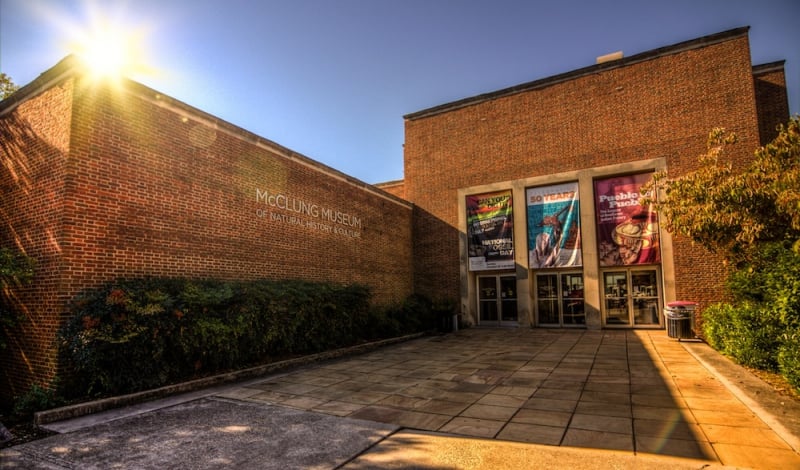
Museum in Knoxville, Tennessee. The McClung Museum of Natural History and Culture is a museum located on the campus of the University of Tennessee in Knoxville. Built in 1963, exhibits focus on natural history, archaeology, anthropology, decorative arts, and local history.
Permanent exhibits include:
- Ancient Egypt: The Eternal Voice — A collection of artifacts from ancient Egypt spanning the pre-dynastic to the Ptolemaic periods.
- Archaeology and the Native Peoples of Tennessee — A collection of artifacts found during the building of dams in the state in the 1930s and 1940s, with examples including the "Sandy" statue found at the Sellars Farm Site, the cache of ceramic figurines found at the Brick Church Mound and Village Site, and the Duck River Cache of ceremonial chert objects discovered at the Duck River Temple Mounds in 1894.
- The Civil War in Knoxville: The Battle of Fort Sanders — Provides an overview of the broad context of the American Civil War, while highlighting the specific, pivotal role that Knoxville played in the Battle of Fort Sanders.
- The Decorative Experience — A collection of art from various times and cultures from around the world.
- Geology and Fossil History of East Tennessee — A collection of Tennessee fossils representing a comprehensive overview of geological history. Outside of the main building, the museum's most prominent and popular exhibit is a replica of an Edmontosaurus annectens, nicknamed "Monty" by the students at the University of Tennessee.
- Human Origins: Searching for Our Fossil Ancestors — A concise overview of the current scientific understanding regarding human evolution.
- Tennessee Freshwater Mussels — A collection displaying the incredible diversity of freshwater pearl mussels in Tennessee.
In addition, the McClung Museum houses special exhibitions that temporarily showcase art or artifacts from other collections or institutions. The McClung Museum is accredited by the American Alliance of Museums and is an affiliate of the Smithsonian Institution.[22]
Address: 1327 Circle Park Dr, 37916 Knoxville
St. John's Cathedral
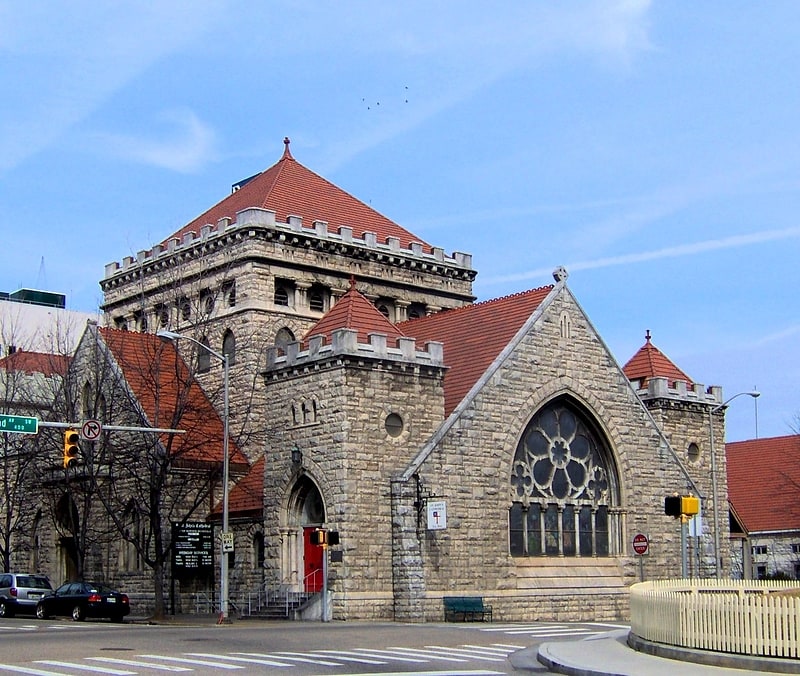
Cathedral in Knoxville, Tennessee. St. John's Cathedral located at 413 Cumberland Avenue in Knoxville, Tennessee, is the cathedral church of the Episcopal Diocese of East Tennessee.[23]
Address: 413 Cumberland Ave, 37902-2302 Knoxville
Sharp's Ridge
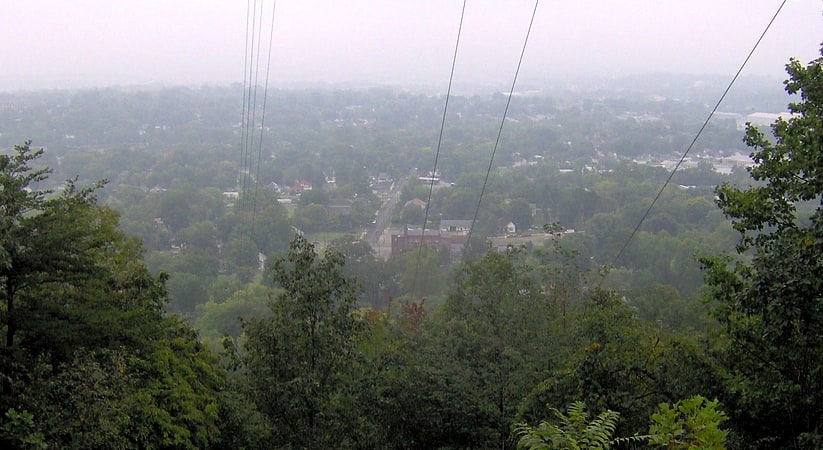
Ridge. Sharp's Ridge is a steep ridge in Knoxville, Tennessee, north of the city's downtown. A 111-acre area of the 7-mile ridge is maintained as Sharp's Ridge Memorial Park, a city park dedicated to the honor of the area's war veterans. The ridge also is the site of a transmitting antenna farm that serves most of Knoxville's broadcasters. The highest ground point on the ridge is an abandoned fire tower located at 1,391 feet above mean sea level. The ridge itself averages 200 to 300 feet above the surrounding valley floor, allowing panoramic views of the Great Smoky Mountains and adjacent ranges to the east and the Cumberland Plateau and Cumberland Mountains to the west.
Sharp's Ridge is named for the Sharpe family, who lived on the ridge during the 19th century.[24]
Bleak House
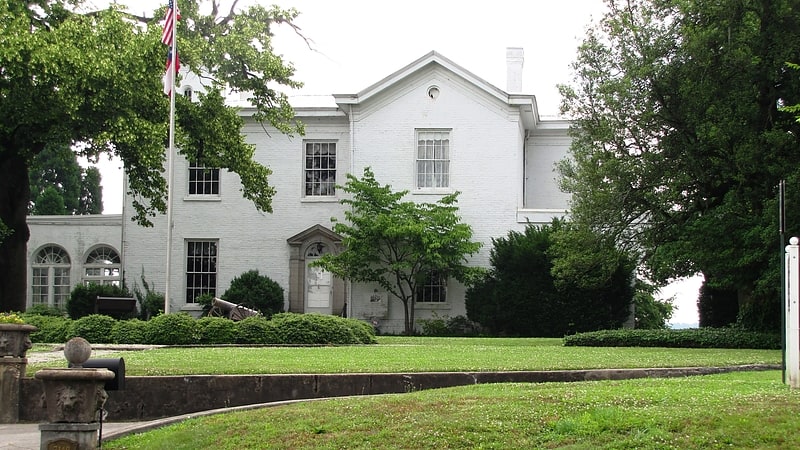
Historical landmark in Knoxville, Tennessee. Bleak House is an antebellum Classical Revival style house in Knoxville, Tennessee. It is on the National Register of Historic Places.[25]
Address: 3148 Kingston Pike, 37919-4627 Knoxville
St. John's Lutheran Church
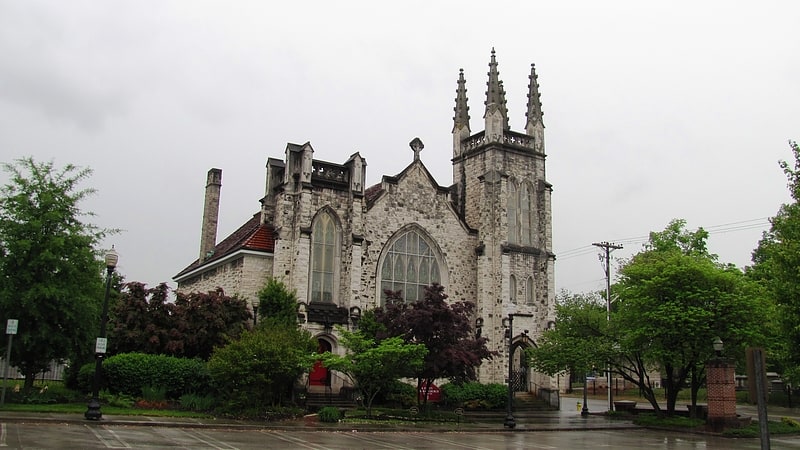
Lutheran church in Knoxville, Tennessee. St. John's Lutheran Church is a historic Lutheran church located at 544 Broadway NW in Knoxville, Tennessee. The church building is listed on the National Register of Historic Places, both individually and as a contributing property in the Emory Place Historic District.[26]
Address: 544 N Broadway, 37917-7427 Knoxville
Central United Methodist Church
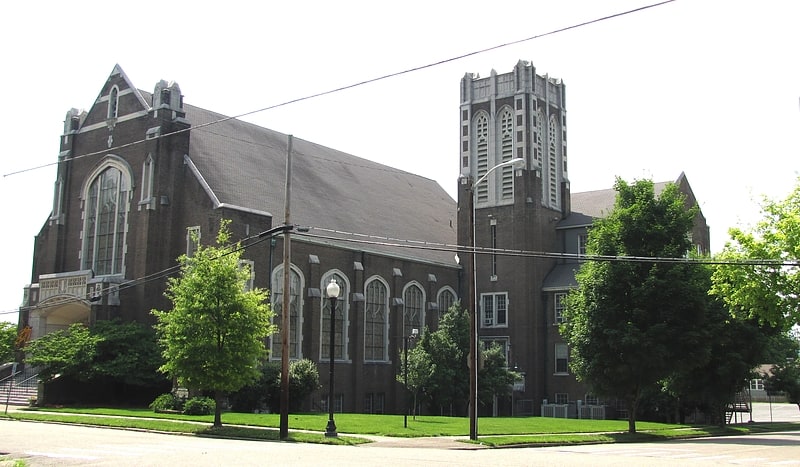
Methodist church in Knoxville, Tennessee. Central United Methodist Church is located at 201 East Third Avenue in Knoxville, Tennessee. On November 9, 2005, it was added to the National Register of Historic Places, and is listed as a contributing property within the Fourth and Gill Historic District.
The church was organized in 1924 as a merger between Broad Street Methodist and Centenary Methodist churches after a fire destroyed the Broad Street building. The present structure was completed in 1927 in the Gothic Revival style. Baumann & Baumann of Knoxville were the architects. The exterior of the church is primarily brick, but also includes stone, limestone and marble. At the time of its completion, the sanctuary was Knoxville's largest church auditorium, seating 1,600. The organ was purchased from the Riviera Theater in 1935.
The congregation is affiliated with the United Methodist Church.[27]
Address: 201 3rd Ave, 37917-7248 Knoxville
Knox County Courthouse

Building. The Knox County Courthouse is a historic building located at 300 Main Street in Knoxville, Tennessee, United States. Built in 1886, it served as Knox County's courthouse until the completion of the City-County Building in 1980, and continues to house offices for several county departments. John Sevier, Tennessee's first governor, is buried on the courthouse lawn. The courthouse is listed on the National Register of Historic Places for its architecture and its role in the county's political history.[28]
First Baptist Church
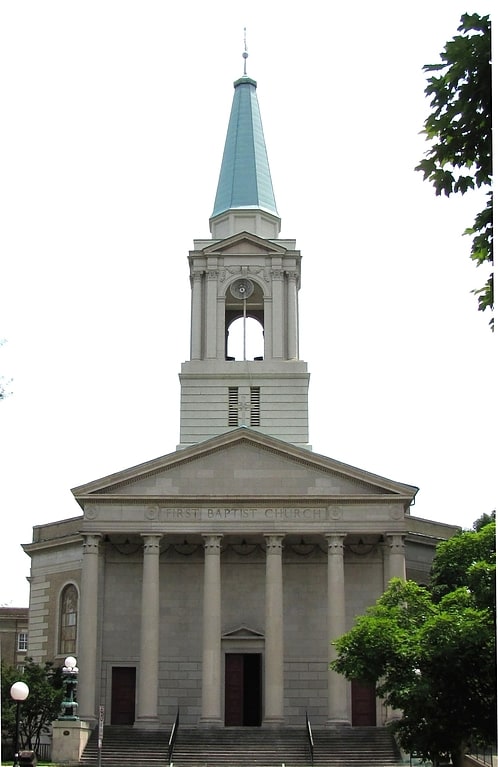
Church in Knoxville, Tennessee. First Baptist Church is a historic church located in Knoxville, Tennessee. It is on the National Register of Historic Places.
The congregation was organized in 1843 by James and John Moses. After its first baptismal service in nearby First Creek, the church had 46 members, including 20 African-Americans. The church organized its first Sunday School in 1845. The first building was constructed on Gay Street in 1844. The second building was built at the same location in 1887. The third (and present) building was completed in 1923 at the Main Street location, three years after Dr. Frederick Fernando Brown became pastor. This architecturally-significant structure, noteworthy for its Neoclassical design and octagonal sanctuary, was designed by Dougherty & Gardner of Nashville, Tennessee, and is modeled on St Martin-in-the-Fields of London. The exterior of the church sanctuary is sheathed in marble, although the adjoining education space is brick. The congregation is moderate, and is member of the Cooperative Baptist Fellowship, a mainline denomination in the South.[29]
Address: 510 W Main St, 37902 Knoxville
Trinity Methodist Episcopal Church
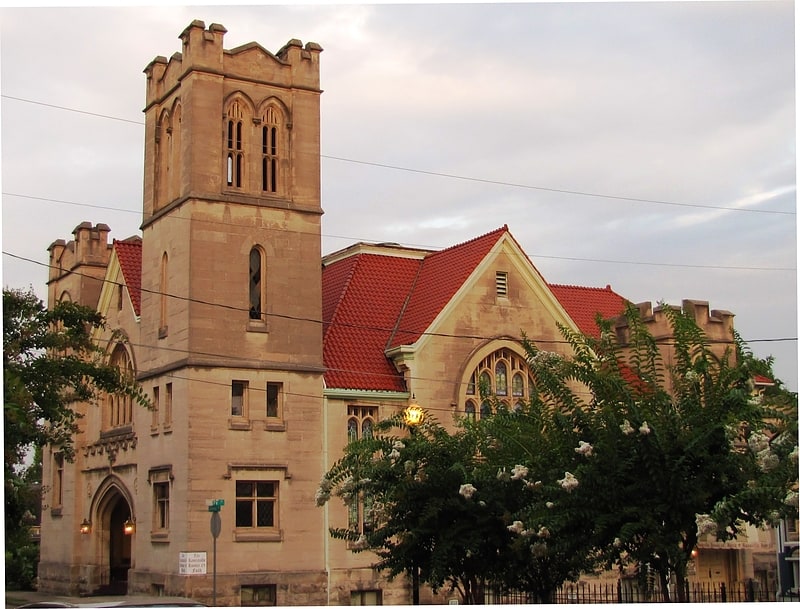
Church in Knoxville. Trinity Methodist Episcopal Church is a historic church at 416 Lovenia Avenue in Knoxville, Tennessee, in the Fourth and Gill historic district.
It was built in 1906 and added to the National Register of Historic Places in 1982. The sanctuary features high vaulted ceilings.
The building currently houses a small Pentecostal congregation.[30]
Address: 416 Lovenia Ave, 37917-7260 Knoxville
Chilhowee Park
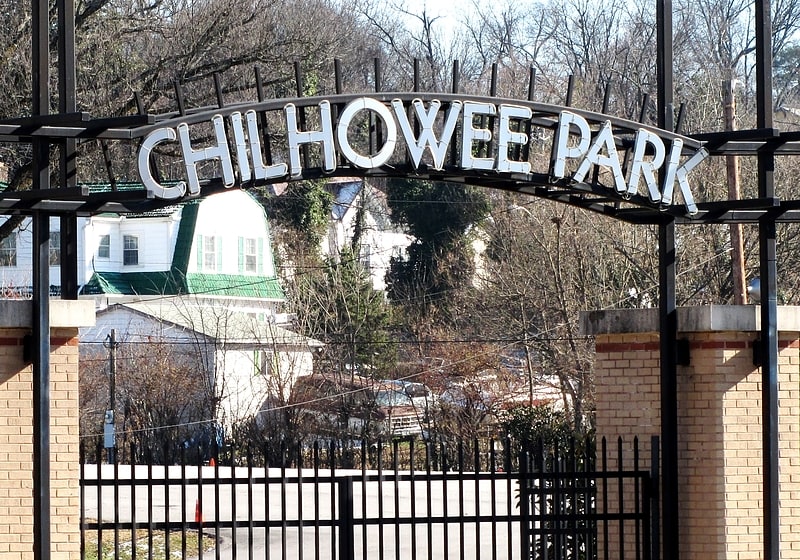
Chilhowee Park is a public park, fairgrounds and exhibition venue in Knoxville, Tennessee, United States, located off Magnolia Avenue in East Knoxville. Developed in the late 19th century, the park is home to the Tennessee Valley Fair and hosts several dozen expositions annually. The park covers 81 acres, and includes a 57,100-square-foot exposition center, a 1910-era bandstand, a 4,500-seat amphitheater, and a 3-acre lake, Lake Ottosee. The park is also home to The Muse Knoxville, a children's science museum formerly known as the East Tennessee Discovery Center.[31]
Address: 3301 Woodbine Ave, 37914 Knoxville (East Knoxville)
Old Gray Cemetery
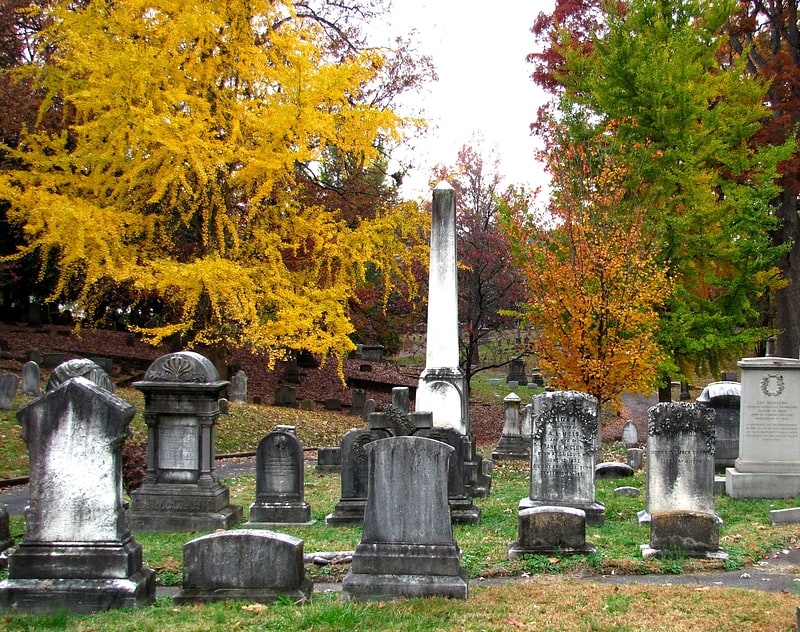
Cemetery in Knoxville, Tennessee. Old Gray Cemetery is the second-oldest cemetery in Knoxville, Tennessee, United States. Established in 1850, the 13.47-acre cemetery contains the graves of some of Knoxville's most influential citizens, ranging from politicians and soldiers, to artists and activists. The cemetery is also noted for the Victorian era marble sculpture and elaborate carvings adorning many of the grave markers and headstones. In 1996, the cemetery was added to the National Register of Historic Places.
Named for English poet Thomas Gray (1716–1771), Old Gray Cemetery is an example of a so-called garden cemetery, a mid-19th-century style that sought the transition of graveyards from urban churchyards to quiet suburban plots. Unlike its crowded predecessor, the First Presbyterian Church Cemetery, Old Gray features spacious graves, grand monuments, and extensive vegetation, and its layout bears more resemblance to a public park. Playwright Tennessee Williams mentions Old Gray in his short story, "The Man in the Overstuffed Chair," and Pulitzer Prize-winning novelist Peter Taylor alludes to the cemetery in his book, In the Tennessee Country. The cemetery was simply known as "Gray Cemetery" until 1892, when "New" Gray Cemetery was established about a mile away.[32]
Address: 543 N Broadway St, 37917-7408 Knoxville
First Presbyterian Church
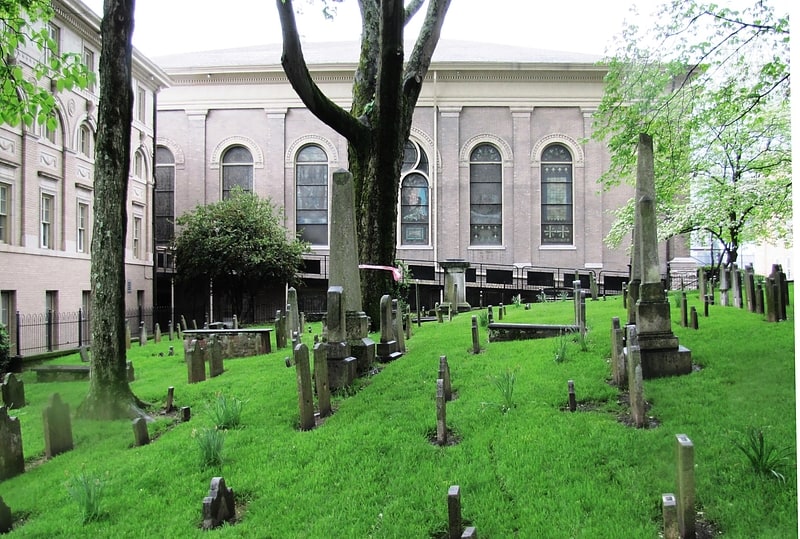
Graveyard. The First Presbyterian Church Graveyard is the oldest graveyard in Knoxville, Tennessee, United States. Established in the 1790s, the graveyard contains the graves of some of Knoxville's most prominent early residents, including territorial governor and Constitutional Convention delegate William Blount and Knoxville founder James White. In 1996, the graveyard was added to the National Register of Historic Places.
While platting Knoxville with his son-in-law, Charles McClung, in 1791, White ordered at least one lot to be set aside for a church and cemetery. The cemetery spot may have been used as early as the 1780s for burials, and the cemetery contained several graves by 1799, but the earliest marker is Blount's, dated 1800. While the First Presbyterian congregation was active in the 1790s, the first church was not built on the site until 1816. The graveyard was used for burials for nearly sixty years, its most active period being during the Epidemic of 1838, in which hundreds of Knoxvillians died from an unidentified illness.[33]
Address: 620 State St, 37902-1216 Knoxville
Craighead–Jackson House
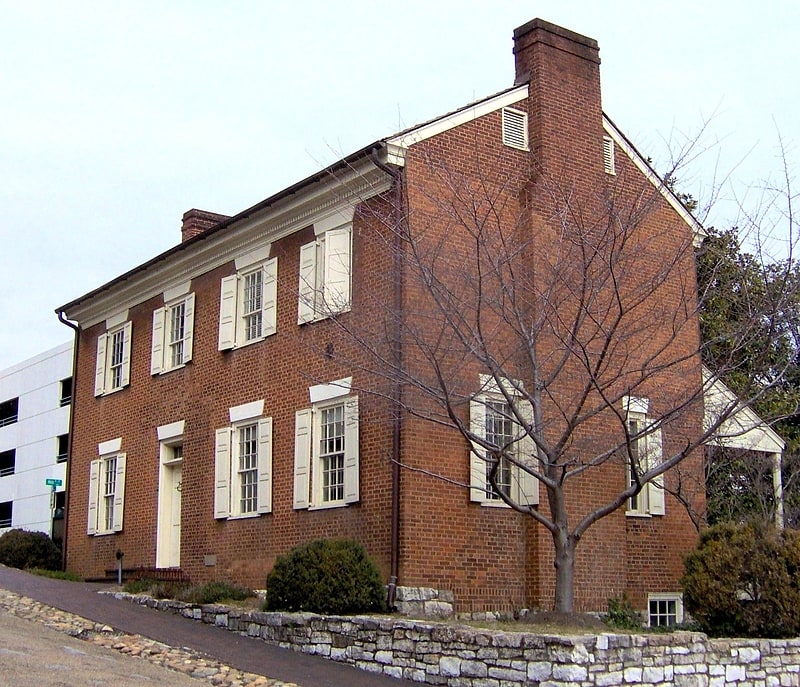
The Craighead–Jackson House is a historic two-story, brick house in Knoxville, in the U.S. state of Tennessee. The home was constructed by John Craighead in 1818 across the street from the William Blount Mansion. The house is on the National Register of Historic Places.
The Craighead family lived in the house until 1855, when it was sold to William Swan. Swan, who later was a member of the Confederate Congress, soon sold the house to George Jackson. The George Jackson family then lived in the home until around 1885. The state of Tennessee and the City of Knoxville purchased the property in 1957 and heavily modified it, before transferring it to the Blount Mansion Association in 1962.
From 1966 to the mid-1990s, the house served as the Blount Mansion visitors center and offices, until it was replaced in this function by a purpose-built visitors center. Subsequently, it was used as archival storage and for occasional special events. In September 2020, a $75,000 grant was obtained to allow for a restoration expected to take 12-18 months, with completion predicted in the fall of 2021.[34]
Museum of East Tennessee History
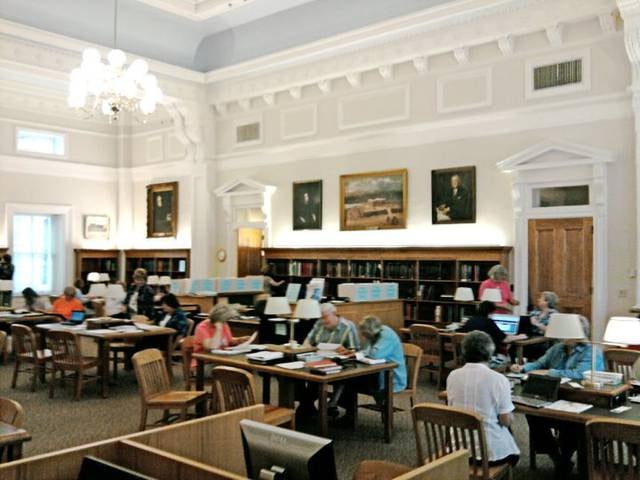
Museum, History museum, Historical place
Address: 601 S Gay St, 37902 Knoxville